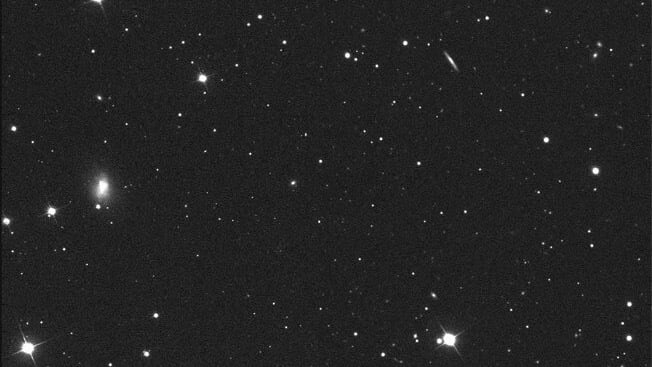Science
Astronomy Students Uncover Secret Supermassive Black Hole

A group of astronomy students from the University of Texas has made a significant discovery about the dwarf galaxy Segue 1, located just 75,000 light-years from Earth. Initially considered a prime candidate for studying dark matter, new research reveals that Segue 1 may actually harbor a previously unknown supermassive black hole, estimated to weigh more than 450,000 solar masses. This finding has implications for the understanding of galaxy formation and the role of black holes in the universe.
The students’ journey began as part of a homework assignment in a course on Galactic and Gravitational Dynamics, taught by professors Karl Gebhardt from the Austin campus and Richard Anantua from the San Antonio campus. The project aimed to utilize computer simulations to explore unseen components of galaxies, specifically focusing on the dynamics of Segue 1.
Unveiling the Hidden Mass
Previous theories suggested that Segue 1’s mass was largely attributed to dark matter, a substance that does not emit light and remains elusive to direct observation. In contrast, the recent study indicated that a supermassive black hole could account for most of the galaxy’s mass. The students, led by graduate student Nathaniel Lujan, utilized advanced computational techniques to analyze the movements of stars within Segue 1.
Through their simulations, the students isolated stars influenced primarily by Segue 1’s gravity, excluding those affected by the Milky Way. They observed that stars near the center of the galaxy were moving in rapid, tight orbits, suggesting the presence of a massive object. Models incorporating a black hole provided the best fit for the data, leading to the groundbreaking conclusion that Segue 1 contains a supermassive black hole at its core.
“It’s amazing,” Lujan stated during a presentation at the American Astronomical Society meeting in Anchorage, Alaska. “I’m suggesting that it hosts a half-million solar-mass supermassive black hole in its center.” This revelation challenges the prevailing notion that dwarf galaxies lack such massive black holes.
Implications for Astronomy
The study, published in The Astrophysical Journal Letters, reflects the evolving understanding of galaxy dynamics and the potential prevalence of supermassive black holes in smaller galaxies. The results may indicate that these massive entities exist in more places than previously thought, even in galaxies considered too small to support them.
Segue 1 was first identified in 2006 by the Sloan Digital Sky Survey telescope. Its lack of stars initially led scientists to hypothesize the existence of a dark matter halo surrounding the galaxy to prevent it from dispersing. This new finding suggests a different narrative, one where the black hole’s influence might redefine how astronomers perceive the structure and behavior of dwarf galaxies.
Lujan plans to further explore these concepts for his doctoral thesis, applying advanced computing and artificial intelligence to simulate other dwarf galaxies previously believed to be dominated by dark matter. The research team is also considering parallels with early universe objects recently identified by NASA’s James Webb Space Telescope, referred to as “little red dots,” which may share characteristics with Segue 1.
Ultimately, this discovery serves as a reminder that innovative approaches to existing data can yield transformative insights. “What gets me really excited is that these galaxies that we’re finding here like Segue 1 may be analogs to the early universe, where the black holes are really massive,” Gebhardt remarked. “Nature has found a way.”
-

 Health3 months ago
Health3 months agoNeurologist Warns Excessive Use of Supplements Can Harm Brain
-

 Health3 months ago
Health3 months agoFiona Phillips’ Husband Shares Heartfelt Update on Her Alzheimer’s Journey
-

 Science1 month ago
Science1 month agoBrian Cox Addresses Claims of Alien Probe in 3I/ATLAS Discovery
-

 Science1 month ago
Science1 month agoNASA Investigates Unusual Comet 3I/ATLAS; New Findings Emerge
-

 Science4 weeks ago
Science4 weeks agoScientists Examine 3I/ATLAS: Alien Artifact or Cosmic Oddity?
-

 Entertainment4 months ago
Entertainment4 months agoKerry Katona Discusses Future Baby Plans and Brian McFadden’s Wedding
-

 Science4 weeks ago
Science4 weeks agoNASA Investigates Speedy Object 3I/ATLAS, Sparking Speculation
-

 Entertainment4 months ago
Entertainment4 months agoEmmerdale Faces Tension as Dylan and April’s Lives Hang in the Balance
-

 World3 months ago
World3 months agoCole Palmer’s Cryptic Message to Kobbie Mainoo Following Loan Talks
-

 Science4 weeks ago
Science4 weeks agoNASA Scientists Explore Origins of 3I/ATLAS, a Fast-Moving Visitor
-

 Entertainment4 months ago
Entertainment4 months agoLove Island Star Toni Laite’s Mother Expresses Disappointment Over Coupling Decision
-

 Entertainment3 months ago
Entertainment3 months agoMajor Cast Changes at Coronation Street: Exits and Returns in 2025









